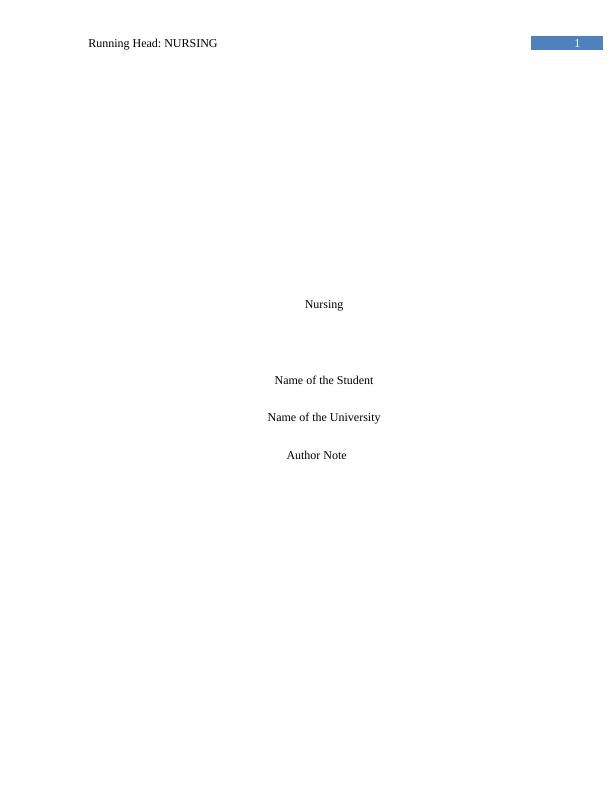HLSC 220 Health Care Ethics
9 Pages2531 Words101 Views
Health Care Ethics (HLSC220)
Added on 2020-05-08
HLSC 220 Health Care Ethics
Health Care Ethics (HLSC220)
Added on 2020-05-08
ShareRelated Documents
1Running Head: NURSINGNursing Name of the StudentName of the University Author Note

2Running Head: NURSINGThe essay deals with the case study of Henry that involves the ethical dilemma pertainingto two different roles. The aim of the essay is to establish clear perspective on the issuesidentified from the case study and recognise the own alternative perspective. Further the essaydiscusses the ethical issues from the perspective of human dignity that needs to be respected,code of ethics, professional standards, ethical theory, and the principles of health care ethics.Lastly, the essay recommends the strategies for professional practice. In the given case study, Henry is a physiotherapist for 8 years and work along with theorthopaedic surgeons, a podiatrist, a rheumatologist, a radiologist, and a massage therapist. Hehas been treating the Jim, a 73 year old man, following bilateral knee replacements. After Jimshowed little improvement in mobility his wife complaint to Henry that Jim is not following theexercise program at house. Henry decided to discontinue the treatment of Jim and suggested torefer the message therapist. However, Sally the practice manager perceives this act of Henrywould lead to loss of organisation’s reputation. On the other hand, he informs Sally that one ofthe surgeons arrives at the workplace in drunken state. He comes smelling alcohol even duringsurgery. Sally is working on this matter. In the given case study the ethical issues at stake are beneficence of patients andmaleficence, breach of code of conduct, human rights, professional standards and clinicalnegligence. From an alternative perspective, it can be said that Henry has met other criteria ofethical framework that is prioritisation (Bryant et al., 2014). He considered other awaitingpatients to be his first priority instead of Jim. This decision is in accordance with ethicalframework but keeps other ethical issues at stake.

3Running Head: NURSINGFrom the perspective of the Physiotherapist, discontinuing the treatment of Jim by Henrycan be called a clinical negligence. According to Breen & Weisbrot (2015), negligence is thebreach of the duty of care, which may cause damage to the patient’s health. It may lead to claimsagainst the physiotherapist. Discontinuing the treatment of Jim may have adverse consequencesas Jim had not completely recovered. He needs greater attention till his mobility has increased.Referring to massage therapist at this stage may increase the rate of complication. Henry shouldhave first conducted the assessment of Jim to know the condition of his knee and reason forpatient’s unwillingness to perform exercises. Henry in the quest to attend other awaiting patientsneglected the care for Jim. It may worsen the Jim’s condition. It can be interpreted that theethical principle of beneficence was no followed by Henry. According to Butts & Rich (2015),beneficence is the action that promotes the well being of the patients. Henry did not serve in thebest interest of the patient. Henry also seems to breach the ethical principle of non-maleficencebecause without evaluating the need of massage therapist, he discontinued the treatment.According to Tarzian et al. (2015), non-maleficence is the use of treatment that does no harm thepatient. The act of surgeon arriving at the workplace smelling alcohol is the breach of the code ofconduct for doctors in Australia developed by the Medical board. The code of conduct andprofessional standards emphasise on professional behaviour of surgeons and doctors thatdemonstrates trust and respect to the patients (Medicalboard.gov.au., 2017). Doctors must notcross their professional boundaries. However, attending the work in drunken state involves ahigh chance of patient injury such as wrongful amputation, incorrect diagnosis, waking up duringanaesthesia and others. Such injuries may lead to death of patient instead of promoting the well-being. It indicates the breach of the duty to take care of the patient. This harm could be avoidable

End of preview
Want to access all the pages? Upload your documents or become a member.
Related Documents
Health and Social Care Ethics : Assignmentlg...
|12
|2912
|73
Nursing Ethics Assignmentlg...
|10
|2948
|42
Ethical Principles in Healthcare Assignmentlg...
|12
|2928
|117
Health Care Ethics: Case Studylg...
|12
|2917
|292
End-of-life Care: Legal, Ethical Issues, Decision Making, Holistic Care Plan, Self-carelg...
|12
|2577
|266
